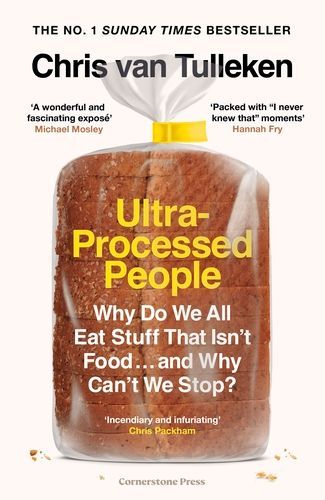
Ultra-Processed People Why Do We All Eat Stuff That Isn’t Food ... and Why Can’t We Stop?
THE NUMBER ONE SUNDAY TIMES BESTESLLER 'If you only read one diet or nutrition book in your life, make it this one' Bee Wilson 'A devastating, witty and scholarly destruction of the shit food we eat and why' Adam Rutherford --- An eye-opening investigation into the science, economics, history and production of ultra-processed food. It's not you, it's the food. We have entered a new 'age of eating' where most of our calories come from an entirely novel set of substances called Ultra-Processed Food, food which is industrially processed and designed and marketed to be addictive. But do we really know what it's doing to our bodies? Join Chris in his travels through the world of food science and a UPF diet to discover what's really going on. Find out why exercise and willpower can't save us, and what UPF is really doing to our bodies, our health, our weight, and the planet (hint: nothing good). For too long we've been told we just need to make different choices, when really we're living in a food environment that makes it nigh-on impossible. So this is a book about our rights. The right to know what we eat and what it does to our bodies and the right to good, affordable food.
Reviews
Fasiha🌺🐧@faszari98
Laura Dobie@MovingToyshop
Ben@bingobongobengo
Anton Sten@antonsten
Will Dawson@willdawson
Kebo@kebo
Nicole Elora@nicoleelora
Jaclyn Rye@jackierabbit
Navya R@navyarav
Dalia Ergas@dalia
Oliver Magnanimous@oliverm
James Greeley@jamesgreeley
Karolina Klermon-Williams@ofloveandart
Highlights
Laura Dobie@MovingToyshop
Laura Dobie@MovingToyshop
Laura Dobie@MovingToyshop
Laura Dobie@MovingToyshop
Laura Dobie@MovingToyshop
Laura Dobie@MovingToyshop
Laura Dobie@MovingToyshop
Laura Dobie@MovingToyshop
Laura Dobie@MovingToyshop
Laura Dobie@MovingToyshop
Laura Dobie@MovingToyshop
Laura Dobie@MovingToyshop
Laura Dobie@MovingToyshop
Laura Dobie@MovingToyshop
Laura Dobie@MovingToyshop
Laura Dobie@MovingToyshop
Laura Dobie@MovingToyshop
Laura Dobie@MovingToyshop
Laura Dobie@MovingToyshop
Will Dawson@willdawson
Will Dawson@willdawson
Page 76